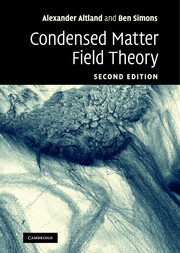Book contents
- Frontmatter
- Contents
- Preface
- 1 From particles to fields
- 2 Second quantization
- 3 Feynman path integral
- 4 Functional field integral
- 5 Perturbation theory
- 6 Broken symmetry and collective phenomena
- 7 Response functions
- 8 The renormalization group
- 9 Topology
- 10 Nonequilibrium (classical)
- 11 Nonequilibrium (quantum)
- Index
11 - Nonequilibrium (quantum)
Published online by Cambridge University Press: 04 August 2010
- Frontmatter
- Contents
- Preface
- 1 From particles to fields
- 2 Second quantization
- 3 Feynman path integral
- 4 Functional field integral
- 5 Perturbation theory
- 6 Broken symmetry and collective phenomena
- 7 Response functions
- 8 The renormalization group
- 9 Topology
- 10 Nonequilibrium (classical)
- 11 Nonequilibrium (quantum)
- Index
Summary
In the previous chapter we have seen that departures from equilibrium generate a plethora of new phenomena in statistical physics. While our discussion so far has been limited to classical phenomena, in this chapter we want to ask how quantum mechanics interferes with the conditions of nonequilibrium. Experience shows that, in some cases, nonequilibrium quantum systems can be understood in terms of reasonably straightforward quantization of their classical limits. In others, an interplay of quantum coherence and nonequilibrium driving leads to entirely new phenomena – such as lasing, a paradigm for a steady state nonequilibrium quantum system. At any rate, we have every reason to anticipate that quantum nonequilibrium physics will be as diverse and colourful as its classical counterpart.
Even minor departures from equilibrium call for a theoretical description entirely different from the ‘Matsubara formalism’ developed in earlier chapters of this book. The applicability of the latter is rigidly tied to the existence of a quantum grand canonical density operator, the hallmark of a many particle equilibrium system. But how then, can an functional theory of nonequilibrium quantum systems be developed? An obvious idea would be to once more go through the different elements of classical nonequilibrium theory developed in the previous chapter, and subject every one of them to an individual quantization scheme. Luckily, there are more efficient ways to achieve our goal: some decades ago, a many particle formalism suitable to describe nonequilibrium systems under the most general conditions was introduced by Keldysh.
- Type
- Chapter
- Information
- Condensed Matter Field Theory , pp. 693 - 765Publisher: Cambridge University PressPrint publication year: 2010
- 1
- Cited by



